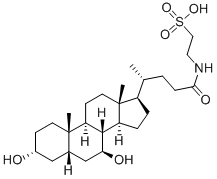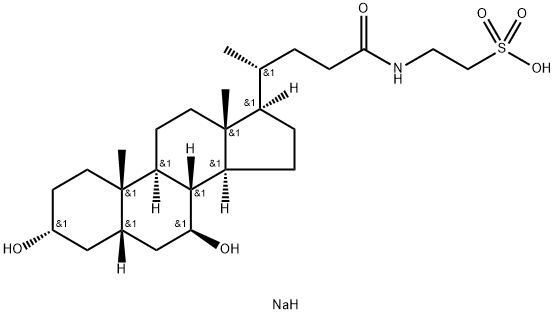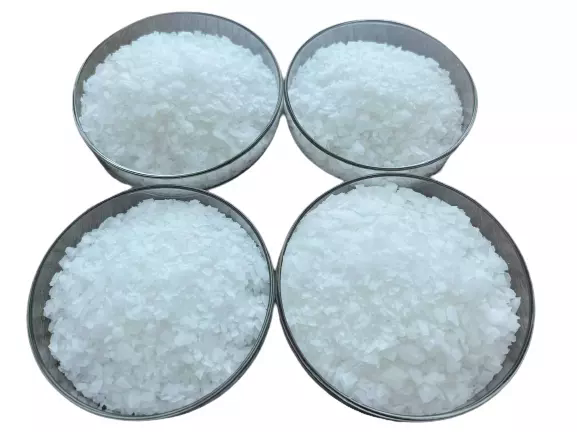Tauroursodeoxycholic acid
Synonym(s):Sodium Tauroursodeoxycholate;Tauroursodeoxycholic Acid, Sodium Salt - CAS 14605-22-2 - Calbiochem
- CAS NO.:14605-22-2
- Empirical Formula: C26H45NO6S
- Molecular Weight: 499.7
- MDL number: MFCD00069496
- EINECS: 1308068-626-2
- SAFETY DATA SHEET (SDS)
- Update Date: 2025-12-26 16:58:18

What is Tauroursodeoxycholic acid?
Toxicity
There is no information available regarding the LD50 and overdose of tauroursodeoxycholic acid.
Description
Tauroursodeoxycholic acid (TUDCA) is a hydrophilic bile acid synthesized in hepatocytes by the conjugation of ursodeoxycholic acid (UDCA) with the amino acid taurine. UDCA, which is made by gut bacteria, is FDAapproved in the United States for the treatment of certain cholestatic liver diseases. Humans make TUDCA to some extent, but it is found in copious amounts in the bile of bears. TUDCA is a classic inhibitor of endoplasmic reticulum (ER) stress. Reduces ER stress and adipose tissue inflammation in a mouse model of high fat diet-induced obesity. Blocks ER stress-induced NLRP3 inflammasome activation and hepatocyte death. Attenuates amyloid precursor protein processing and amyloid-β deposition in APP/PS1 mouse model.
Chemical properties
Tauroursodeoxycholic acid is an off-White Solid. It is an ambiphilic bile acid. It is mainly found in black bear bile, which is the signature active ingredient in bear bile. It has antispasmodic, anticonvulsant, anti-inflammatory and gallstone dissolving effects.
The Uses of Tauroursodeoxycholic acid
Tauroursodeoxycholic acid (TUDCA) is a water-soluble bile salt naturally occurring in the body. When bile salts reach the intestines, they can be metabolized by bacteria into ursodeoxycholic acid (UDCA). TUDCA is formed when taurine binds to UDCA. TUDCA is used to treat cholestasis, a condition in which bile fails to flow from the liver to the duodenum. TUDCA, UDCA, and other soluble bile salts can counteract the toxicity of regular bile acids when the latter are backed up in the liver. TUDCA is also used to treat cholesterol gallstones, dissolving them to a size in which they may be passed.
What are the applications of Application
Tauroursodeoxycholic Acid, Sodium Salt is a bile related salt for isolation of lipids and membrane-bound proteins
Background
Tauroursodeoxycholic acid, also known as ursodoxicoltaurine, is a highly hydrophilic tertiary bile acid that is produced in humans at a low concentration. It is a taurine conjugate of ursodeoxycholic acid with comparable therapeutic efficacy and safety, but a much higher hydrophilicity. Normally, hydrophilic bile acids regulates hydrophobic bile acids and their cytotoxic effects. Tauroursodeoxycholic acid can reduce the absorption of cholesterol in the small intestine, thereby reducing the body's intake of dietary cholesterol and the body cholesterol content.
Tauroursodeoxycholic acid is currently used in Europe to treat and prevent gallstones as a bile acid derivative. Due to a range of its molecular properties - namely its anti-apoptotic effects - tauroursodeoxycholic acid has been examined in inflammatory metabolic diseases and neurodegenerative diseases.
Indications
Tauroursodeoxycholic acid is used to prevent and treat gallstone formation.
Tauroursodeoxycholic acid is used in combination with phenylbutyric acid to treat amyotrophic lateral sclerosis (ALS) in adults.
Definition
ChEBI: Tauroursodeoxycholic acid is a bile acid taurine conjugate derived from ursoodeoxycholic acid. It has a role as a human metabolite, an anti-inflammatory agent, a neuroprotective agent, an apoptosis inhibitor, a cardioprotective agent and a bone density conservation agent. It derives from an ursodeoxycholic acid. It is a conjugate acid of a tauroursodeoxycholate.
Pharmacokinetics
Tauroursodeoxycholic acid works to decrease bile acid and cholesterol levels. It reduces the cholesterol content and increases the bile acid content in gallbladder bile to prevent the formation of cholesterol gallstones.
Tauroursodeoxycholic acid possesses anti-apoptotic and anti-inflammatory properties. These findings provoked the investigations of tauroursodeoxycholic acid as a potential therapeutic agent for neurodegenerative diseases, such as amyotrophic lateral sclerosis, Alzheimer's disease, and Parkinson's disease. Other studies also suggest that tauroursodeoxycholic acid can promote angiogenesis and suppress adipogenesis of adipose-derived mesenchymal stem cells (MSCs). Anti-osteoporotic effects of tauroursodeoxycholic acid have also been documented, as it was shown to enhance osteogenic differentiation of bone marrow-derived MSCs.
Side Effects
TUDCA is safe and well-tolerated in patients with liver transplants, liver cirrhosis, and other diseases, but no clinical data exist for treatments longer than 1 year.
There were no significant differences in adverse events between those receiving standard immunosuppressants versus those receiving bile acids in addition. Other trials in liver cirrhosis (up to 6 months) and ALS (1 year) have also reported that TUDCA is well-tolerated with diarrhea being the only side effect (Elia et al., 2016; Ma et al., 2016; Pan et al., 2013; Crosignani et al., 1996).
Tauroursodeoxycholic-Acid-Cognitive-Vitality-For-Researchers
Metabolism
There is little biotransformation of tauroursodeoxycholic acid. It is partially deconjugated by intestinal microflora to form unconjugated bile acids.
Mode of action
Tauroursodeoxycholic acid is a bile acid taurine conjugate derived from ursodeoxycholic acid. Bile acid is made by the liver and stored in the gallbladder and helps with digestion. It has a role as a human metabolite, an anti-inflammatory agent, a neuroprotective agent, an apoptosis inhibitor, a cardioprotective agent and a bone density conservation agent. TUDCA is found in small quantities in human bile but at a higher concentration in the bile of black bears, which is the signature active ingredient in bear bile. It demonstrates anti-apoptotic activity in rodent models of tauopathy, Huntington's disease, ischemic brain injury, and retinal disorders.
References
1) Xie?et al.?(2002),?Effects of tauroursodeoxycholic acid on endoplasmic reticulum stress-induced caspase-12 activation; Hepatology,?36?592
2) Chen?et al.?(2016),?Chemical chaperones reduce ER stress and adipose tissue inflammation in high fat diet-induced mouse model of obesity; Sci. Rep., 6?27486
3) Lebeaupin?et al. (2015),?ER stress induces NLRP3 inflammasome activation and hepatocyte death; Cell Death Dis.,?6?e1879
4) Nunes?et al.?(2012),?TUDCA, a bile acid, attenuates amyloid precursor protein processing and amyloid-β deposition in APP/PS1 mice; Mol. Neurobiol.?45?440
Properties of Tauroursodeoxycholic acid
| Melting point: | 173-175°C |
| Density | 1.216±0.06 g/cm3(Predicted) |
| refractive index | 46 ° (C=1, EtOH) |
| storage temp. | +15C to +30C |
| solubility | Soluble in DMSO (up to 30 mg/ml) or in Ethanol (up to 20 mg/ml with warming) |
| form | solid |
| pka | 1.42±0.50(Predicted) |
| color | White |
| Stability: | Stable for 1 year from date of purchase as supplied. Solutions in DMSO or ethanol may be stored at -20°C for up to 1 month. |
| CAS DataBase Reference | 14605-22-2(CAS DataBase Reference) |
Safety information for Tauroursodeoxycholic acid
Computed Descriptors for Tauroursodeoxycholic acid
| InChIKey | BHTRKEVKTKCXOH-LBSADWJPSA-N |
| SMILES | [C@@]12([H])CC[C@H]([C@H](C)CCC(=O)NCCS(=O)(=O)O)[C@@]1(C)CC[C@]1([H])[C@@]3(C)CC[C@@H](O)C[C@@]3([H])C[C@H](O)[C@@]21[H] |&1:0,4,5,18,22,24,28,31,34,36,r| |
New Products
4,4-Difluoropiperidine hydrochloride tert-butyl 9-methoxy-3-azaspiro[5.5]undecane-3-carboxylate Indole Methyl Resin N-Isopropylurea N,N-Dicyclohexylcarbodiimide(DCC) MELDRUMS ACID 5-METHYLISOXAZOLE-4-CARBOXYLIC ACID Magnessium Bis glycinate Zinc ascorbate 1-bromo-2-butyne 2-acetamidophenol 9(10H)-anthracenone Erythrosin B, 4-Piperidinopiperidine 2-((4-morpholinophenylamino) (methylthio) methylene) malononitrile 2,4-dihydroxybenzaldehyde 3-(4-morpholinophenylamino)-5-amino-1H-pyrazole-4-carbonitrile Methyl 2-methylquinoline-6-carboxylate 2,6-dichloro-4-nitropyridine 4-Bromo-2-chlorobenzonitrile 2-(benzylamino)acetic acid hydrochloride 4-(tert-Butoxycarbonylamino)but- 2-ynoic acid 3,4-dihydro-2H-benzo[b][1,4]dioxepine 1-Phenyl-1-cycloprppanecarboxylicacidRelated products of tetrahydrofuran



![β-D-Glucopyranosiduronic acid, (3α,5β,7α)-7-hydroxy-24-oxo-24-[(2-sulfoethyl)amino]cholan-3-yl, dipotassium salt (9CI)](https://img.chemicalbook.in/CAS/20211123/GIF/75672-23-0.gif)

![β-D-Glucopyranosiduronic acid, (3α,5β,7β)-7-hydroxy-24-oxo-24-[(2-sulfoethyl)amino]cholan-3-yl, dipotassium salt (9CI)](https://img.chemicalbook.in/CAS/20211123/GIF/75672-32-1.gif)

![2-[[(4R)-4-[(3R,5R,8R,9S,10S,13R,14S,17R)-3-hydroxy-10,13-dimethyl-2,3,4,5,6,7,8,9,11,12,14,15,16,17-tetradecahydro-1H-cyclopenta[a]phenanthren-17-yl]pentanoyl]amino]ethanesulfonic acid](https://img.chemicalbook.in/CAS/GIF/516-90-5.gif)
You may like
-
 Tauroursodeoxycholic acid sodium 98%View Details
Tauroursodeoxycholic acid sodium 98%View Details -
 Tauroursodeoxycholic acid 97% CAS 14605-22-2View Details
Tauroursodeoxycholic acid 97% CAS 14605-22-2View Details
14605-22-2 -
 Tauroursodeoxycholic acid sodium salt 95% CAS 14605-22-2View Details
Tauroursodeoxycholic acid sodium salt 95% CAS 14605-22-2View Details
14605-22-2 -
 Tauroursodeoxycholic acid dihydrate 98.00% CAS 14605-22-2View Details
Tauroursodeoxycholic acid dihydrate 98.00% CAS 14605-22-2View Details
14605-22-2 -
 Tauroursodeoxycholic Acid Dihydrate CAS 14605-22-2View Details
Tauroursodeoxycholic Acid Dihydrate CAS 14605-22-2View Details
14605-22-2 -
 20677-73-0 (2,2-diethoxyethyl)methylamine 98%View Details
20677-73-0 (2,2-diethoxyethyl)methylamine 98%View Details
20677-73-0 -
 3-(4-(hydroxyamino)-1-oxoisoindolin-2-yl)piperidine-2,6-dione 98%View Details
3-(4-(hydroxyamino)-1-oxoisoindolin-2-yl)piperidine-2,6-dione 98%View Details -
 57381-49-4 2-bromo-4-chlorobenzonitrile 98%View Details
57381-49-4 2-bromo-4-chlorobenzonitrile 98%View Details
57381-49-4
